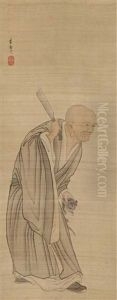Gentai Sanjin Paintings
Gentai Sanjin, also known as Honda Gentatsu, was a Japanese artist and scholar from the Edo period. Born in 1749 in the province of Hoki (present-day Tottori Prefecture), Gentai was known for his diverse talents in poetry, calligraphy, and painting. His artistry was an embodiment of the literati style, which was highly influenced by Chinese scholarly traditions. As a literati artist, Gentai emphasized self-expression and personal cultivation over formal training and professional recognition.
Gentai's works often incorporated elements of nature, with a particular emphasis on landscapes and floral subjects. His style was characterized by a sense of spontaneity and freedom, reflecting the literati ideal of naturalness in art. His calligraphy and paintings were marked by their elegant and refined brushwork, which demonstrated his deep knowledge of Chinese art and literature. Throughout his life, Gentai was also involved in the intellectual and cultural circles of his time, engaging with various scholars and artists.
The Edo period was a time of relative peace and stability in Japan, which allowed for the flourishing of arts and culture. Gentai's contributions to the arts were part of this broader cultural renaissance. His works were appreciated by a cultured elite who valued the scholarly ideals that he represented. Despite his influence, many details about Gentai's life and career remain obscure, and he is not as widely known today as some of his contemporaries.
After a long life dedicated to the arts and scholarship, Gentai Sanjin passed away in 1832. His legacy is preserved through his remaining works and his influence on Japanese literati culture. Gentai's art continues to be studied by scholars interested in the cultural history of Japan and the development of literati art traditions.

